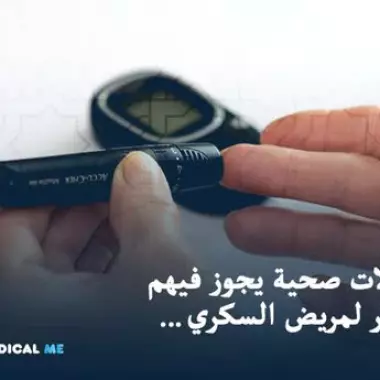كل شخص مريض سكري يحاول دائماً متابعة نسبة السكر في الدم بشكل دوري لملاحظة تحسن الحالة وتجنب أي مضاعفات؛ لذلك ينصح العديد من الأطباء بضرورة اقتناء جهاز قياس سكر منزلي في تلك الحالات لمتابعة نسبة السكر قبل وبعد الأكل ومن هنا نجد أن شرائط قياس السكر هي مفتاح إجراء هذا التحليل المنزلي.
ربما لا ندرك أهمية تلك الشرائط البلاستيكية الصغيرة التي تستخدم مرة واحدة فقط ولكنها تلعب دوراً هاماً في عملية القياس وتؤثر بشكل أو بآخر على دقة التحليل وتوجد أيضاً طرق معينة لحفظ تلك الشرائط وعوامل تساهم في دقة التحليل، هذا ما سنتعرف عليه في هذا المقال.
طريقة عمل شرائط قياس السكر .. ولماذا تؤثر في دقة القياس؟
ربما تتساءل لماذا تؤثر تلك الشرائط البلاستيكية في دقة النتائج هذا لأنها ليست مجرد شرائط كما تبدو لك بل هي شرائط حساسة جداً لما تحتويه من إنزيمات ومواد كيميائية تتفاعل مع قطرة الدم التي توضع عليها ثم تنتج تياراً يتحرك إلى الجهاز فتظهر النتيجة على الشاشة.
كيفية عمل شرائط تحليل السكر
شرائط جهاز السكر، المعروفة أيضًا باسم شرائط اختبار الجلوكوز، هي أحد الأدوات الطبية المستخدمة لقياس مستوى السكر في الدم. تستخدم هذه الشرائط مع جهاز قياس السكر في الدم (جهاز قياس الجلوكومتر) للحصول على قراءة دقيقة لمستوى الجلوكوز في الدم.
تختلف طريقة عمل الشرائط حسب النوع، إذ توجد بعض أنواع شرائط قياس السكر مغلفة بطبقة رقيقة جداً من الذهب التي تتحلل عند ملامسة عينة الدم للشريط، تحتوي أيضاً أطراف شرائط قياس السكر على مواد كيميائية تمتص الجلوكوز الموجود في عينة الدم وتحوله إلى تيار كهربائي يتحرك خلال شريط قياس السكر ماراً بالجهاز لتظهر عليه النتائج، فكلما كانت نسبة الجلوكوز في الدم كبيرة كان التيار الكهربائي الناتج أشد قوة تصبح الأرقام الظاهرة على جهاز قياس السكر أعلى.
توجد شرائط أخرى تحتوي على إنزيم جلوكوز أوكسيداز Glucose oxidase تتفاعل مع الجلوكوز الموجود في عينة الدم الدقيقة التي توضع على طرف الشريط منتجة جلوكونيك أسيد.
يعتمد التيار الذي ينتج على أطراف شرائط قياس السكر المقابلة للجهاز على نسبة الجلوكونيك أسيد الناتجة فتظهر النتيجة على شاشة جهاز قياس السكر بناءً على ذلك.
تعتمد نسبة النتائج على كمية الجلوكونيك أسيد المتكونة بعد اتحاد الجلوكوز الموجود في الدم مع الإنزيم الموجود على الشرائط.
كمية الدم اللازمة لتحليل السكر المنزلي:
تحتاج معظم شرائط تحليل السكر قطرة دم واحدة فقط للحصول على نتيجة دقيقة، وتتراوح تلك النسبة بين 0.5 μl إلى 1 μl حسب الجهاز؛ لذلك عليك الالتزام بكمية العينة المدرجة على العلبة من الخارج.
توجد بعض أجهزة قياس السكر المنزلية التي تعطي إنذار إذا كانت عينة الدم غير كافية وتتيح لك مدة 10 ثواني لوضع قطرة أخرى من الدم للحصول على نتائج دقيقة مثل: جهاز قياس السكر أكيو تشيك الألماني accu chek، تساعد تلك الأجهزة في توفير شرائط تحليل السكر وعدم الحاجة إلى تغيير الشريط إذا كانت عينة الدم غير كافية.
ما هي العوامل التي تؤثر على دقة شرائط قياس السكر؟
- تاريخ الصلاحية المدون على العبوة، يجب الالتزام بمدة صلاحية شرائط قياس السكر المدونة على العلبة؛ لأنه كما ذكرنا تحتوي الشرائط على إنزيم ومواد كيميائية معينة، فعند انتهاء صلاحية الشرائط لا تُعطي نتائج دقيقة عند القياس.
- الرطوبة ودرجة الحرارة، لذلك يجب غلق العبوة جيداً فور إخراج الشريط من العلبة لأنها مصنوعة بمواصفات معينة تحمي تلك الشرائط الحساسة من الرطوبة ودرجة الحرارة.
- عدم كفاية عينة الدم المدرجة على الشريط؛ وذلك لأن النتيجة تعتمد على نسبة الجلوكوز في عينة الدم التي اتحدت مع الإنزيمات والمواد الكيميائية الموجودة على شريط قياس السكر؛ مما يجعله يتحكم في النتيجة التي تظهر على شاشة الجهاز، وبالتالي إذا كانت عينة الدم غير كافية تكون كمية تكون النتائج الظاهرة على شاشة الجهاز غير صحيحة.
- طريقة إدخال الشريط في الجهاز، توجد العديد من الشرائط التي تحتوي على أسهم تسهل عليك إدخال شريط قياس السكر بشكل صحيح.
- استخدام شرائط تالفة أو مكسورة يؤثر بشكل جذري على دقة النتائج.
- استخدام شرائط غير مخصصة للجهاز لأن آلية عمل كل جهاز تتوافق مع الشرائط الخاصة به؛ لذلك لا يمكن استخدام شرائط غير مخصصة لجهاز قياس السكر لديك.
عوامل أخرى تؤثر على دقة نتائج تحليل السكر باستخدام جهاز السكر المنزلي:
- الأصابع المتسخة.
- الأصابع المبللة.
- إذا كان جهاز قياس السكر غير نظيف.
طريقة استخدام شرائط قياس السكر:
- تُفتح عبوة شرائط تحليل السكر التي في الغالب تحتوي على 50 شريط، وتوجد أنواع أخرى تقسم الشرائط على عبوتين فنجد العبوة تحتوي على 25 شريط (تساعد تلك الميزة على الحفاظ على شرائط قياس السكر لوقت أطول).
- يُخرج الشريط من العبوة وتُغلق على الفور ثم يُدرج الشريط في الجهاز.
- قم بوخز إصبعك باستخدام قلم الشكاكة ثم توضع العينة على الشريط لكي تمتصها بواسطة المواد الكيميائية الموجودة على الشريط لتظهر النتائج على الجهاز في غضون ثواني.
شرائط قياس السكر المتوفرة لدى ميديكال مي:
لدينا أكثر من 30 نوع من أنواع شرائط قياس السكر بسعر جملة
- شرائط قياس السكر جلوكو دكتور الكوري.
- شرائط سكر أكيوتشيك أكتيف.
- شرائط تحليل سكر بيونيم أصفر.
- شرائط قياس السكر one touch select.
- شرائط ماتش لقياس السكر وهي من أرخص شرائط قياس السكر.
- شرائط أكيو تشيك بيرفورما.
- أون كول بلاس شرائط سكر.
- شرائط جلوكوستار.
- بيونيم أزرق شرائط.
- شرائط فاين تست.
- شرائط تحليل السكر فري ستايل أوبتيوم.
- شرائط جهاز قياس السكر Contour تي إس.
- شرايط وان تاتش ألترا.
- شرايط تحليل السكر جلوكوستار تي تي.
- شرايط قياس السكر كليفر تشيك.
- شرائط بريسي تشيك.
- فري ستايل لايت شرايط سكر.
- شرائط جهاز السكر إس دي تشيك.
- شرائط كود فري.
- شرائط إليمنت.
- شرائط سيرا تشيك.
- شرائط سمارت تست.
- شرائط جلوكو ستار2.
- شرائط تانجو.
- شرائط جلوكودكتور أوتو.
- شرائط كليفر تشك.
- شرائط سكر دايركت.
- شرائط قياس السكر Accu chek إنستانت.
- شرائط اختبار one touch select plus.
- شرائط تحليل السكر بيرفيكتا.

























